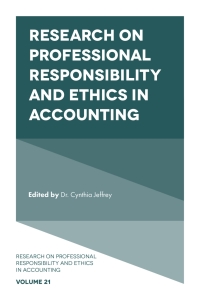Answered step by step
Verified Expert Solution
Question
1 Approved Answer
PLEASE ANSWER ALL QUESTION !! WILL !! all questions are from the same problem Sweeten Company had no jobs in progress at the beginning of
PLEASE ANSWER ALL QUESTION !! WILL !! all questions are from the same problem 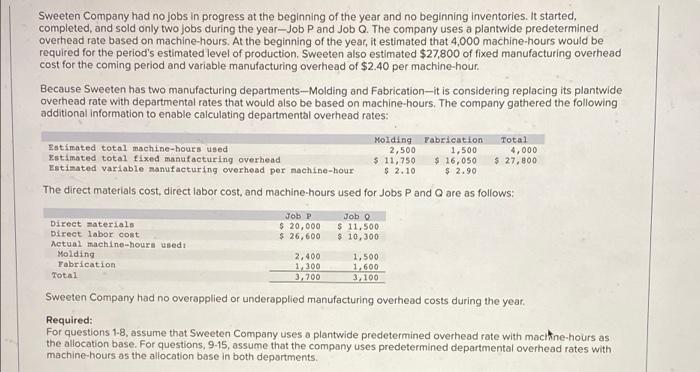
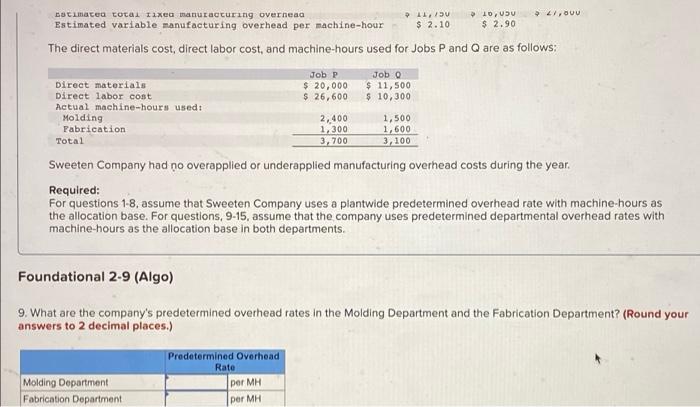
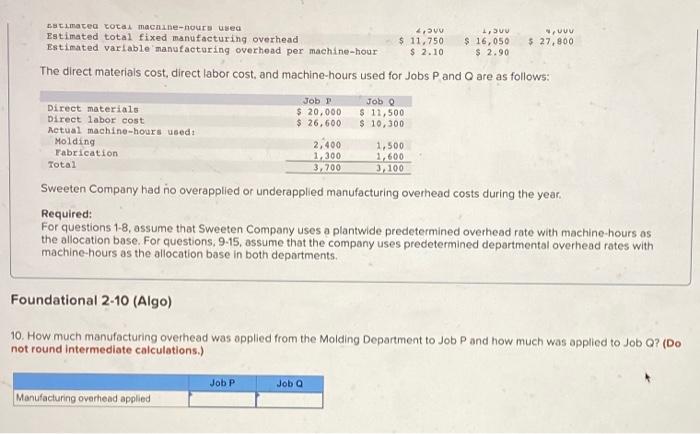
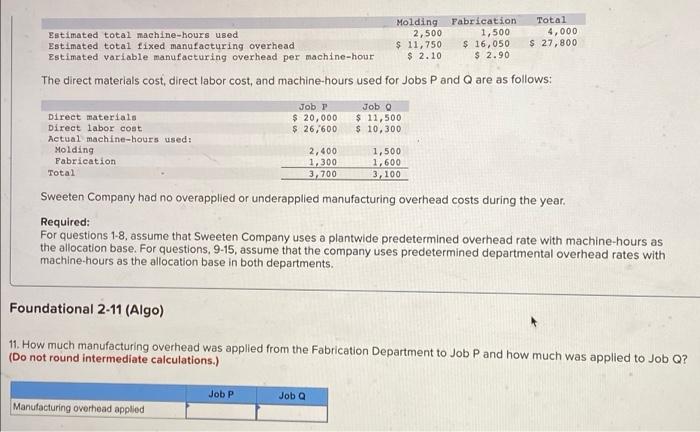
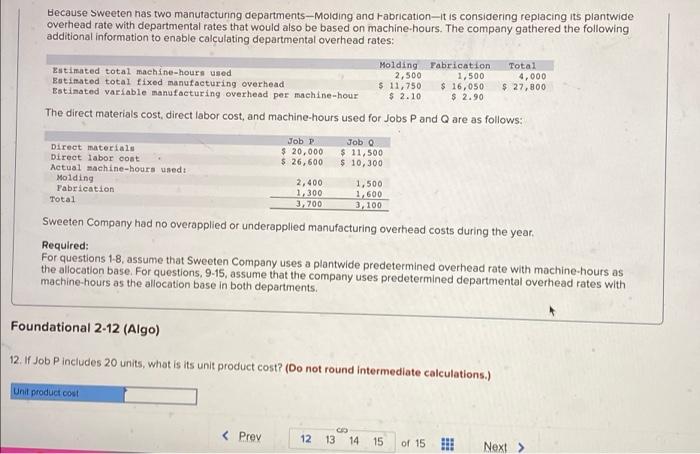
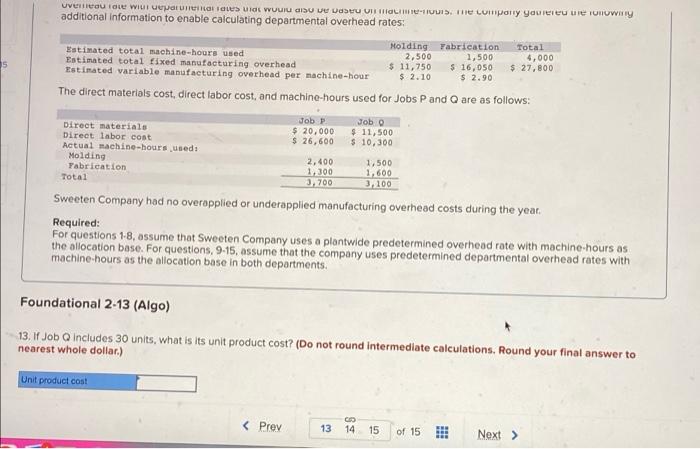
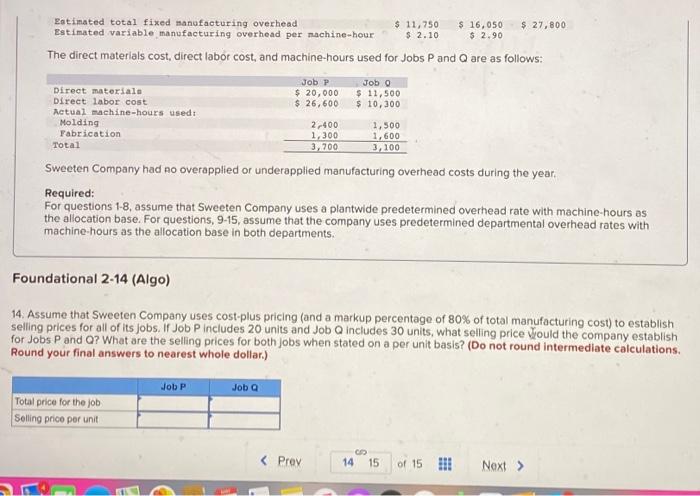
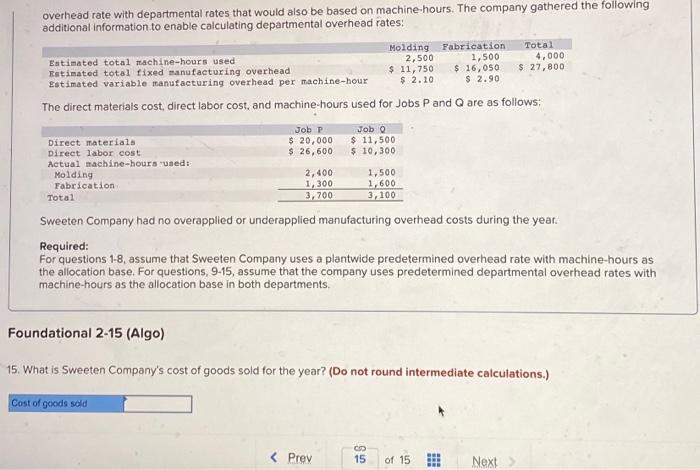
Sweeten Company had no jobs in progress at the beginning of the year and no beginning inventories. It started, completed, and sold only two jobs during the year-Job P and Job Q. The company uses a plantwide predetermined overhead rate based on machine-hours. At the beginning of the year, it estimated that 4,000 machine-hours would be required for the period's estimated level of production, Sweeten also estimated $27,800 of fixed manufacturing overhead cost for the coming period and variable manufacturing overhead of $2.40 per machine-hour. Because Sweeten has two manufacturing departments--Molding and Fabrication-It is considering replacing its plantwide overhead rate with departmental rates that would also be based on machine-hours. The company gathered the following additional Information to enable calculating departmental overhead rates: Molding Fabrication Total Estimated total machine-hours used 2,500 1,500 4,000 Estimated total fixed manufacturing overhead $ 11,750 $ 16,050 $ 27,800 Estimated variable manufacturing overhead per machine-hour $ 2.10 $ 2.90 The direct materials cost direct labor cost, and machine-hours used for Jobs P and Q are as follows: Job P Job Direct materials $ 20,000 $ 11,500 Direct labor cost $ 26,600 $ 10,300 Actual machine-hours used Molding 2.400 1,500 Tabrication 1,300 1.600 Total 3,700 3.100 Sweeten Company had no overapplied or underapplied manufacturing overhead costs during the year. Required: For questions 1-8, assume that Sweeten Company uses a plantwide predetermined overhead rate with macine-hours as the allocation base. For questions, 9-15, assume that the company uses predetermined departmental overhead rates with machine-hours as the allocation base in both departments ,11 + 21,DUU 10, VDU $ 2.90 stimatea total fixea manutacturing overneaa Estimated variable manufacturing overhead per machine-hour $ 2.10 The direct materials cost, direct labor cost, and machine-hours used for Jobs P and Q are as follows: Job P $ 20,000 $ 26,600 Job $ 11,500 $ 10,300 Direct materials Direct labor cost Actual machine-hours used: Molding Fabrication Total 2,400 1.300 3,700 1,500 1,600 3,100 Sweeten Company had no overapplied or underapplied manufacturing overhead costs during the year. Required: For questions 1-8, assume that Sweeten Company uses a plantwide predetermined overhead rate with machine-hours as the allocation base. For questions, 9-15, assume that the company uses predetermined departmental overhead rates with machine-hours as the allocation base in both departments. Foundational 2-9 (Algo) 9. What are the company's predetermined overhead rates in the Molding Department and the Fabrication Department? (Round your answers to 2 decimal places.) Predetermined Overhead Rate per MH Molding Department Fabrication Department per MH LLLmate total machine-nours used 4,0 suu vuu Estimated total fixed manufacturing overhead $ 11,750 $ 16,050 $ 27.800 Estimated variable manufacturing overhead per machine-hour $ 2.10 $ 2.90 The direct materials cost, direct labor cost, and machine-hours used for Jobs P and are as follows: Job Job Direct materials $ 20,000 $ 11,500 Direct labor cost $ 26,600 $ 10,300 Actual machine-hours used Molding 2,400 1,500 Fabrication 1.300 1,600 Total 3.700 3,100 Sweeten Company had no overapplied or underapplied manufacturing overhead costs during the year. Required: For questions 1-8, assume that Sweeten Company uses a plantwide predetermined overhead rate with machine hours as the allocation base. For questions, 9-15, assume that the company uses predetermined departmental overhead rates with machine-hours as the allocation base in both departments. Foundational 2-10 (Algo) 10. How much manufacturing overhead was applied from the Molding Department to Job P and how much was applied to Job O? (DO not round intermediate calculations.) Job P Job Q Manufacturing overhead applied Molding Fabrication Total Estimated total machine-hours used 2,500 1,500 4,000 Estimated total fixed manufacturing overhead $ 11,750 $ 16,050 $ 27,800 Estimated variable manufacturing overhead per machine-hour $ 2.10 $ 2.90 The direct materials cost direct labor cost, and machine-hours used for Jobs P and Q are as follows: Job Job o Direct materials $ 20,000 $ 11,500 Direct labor cost $ 26,600 $ 10,300 Actual machine-hours used: Molding 2,400 1,500 Fabrication 1,300 1,600 Total 3,700 3,100 Sweeten Company had no overapplied or underapplied manufacturing overhead costs during the year. Required: For questions 1-8, assume that Sweeten Company uses a plantwide predetermined overhead rate with machine-hours as the allocation base. For questions, 9-15, assume that the company uses predetermined departmental overhead rates with machine-hours as the allocation base in both departments, Foundational 2-11 (Algo) 11. How much manufacturing overhead was applied from the Fabrication Department to Job P and how much was applied to Job Q? (Do not round intermediate calculations.) Job P Job Q Manufacturing overhead applied Because sweeten nas two manufacturing departments-Molding and Fabrication-It is considering replacing its plantwide overhead rate with departmental rates that would also be based on machine hours. The company gathered the following additional information to enable calculating departmental overhead rates: Molding Fabrication Total Estimated total machine-hours used 2,500 1,500 4,000 Estimated total fixed manufacturing overhead $ 11,750 $ 16,050 $ 27,800 Estimated variable manufacturing overhead per machine-hour $ 2.10 $ 2.90 The direct materials cost, direct labor cost, and machine-hours used for Jobs P and Q are as follows: Job P $ 20,000 $ 26,600 Job O $ 11,500 $ 10,300 Direct materials Direct labor cont Actual machine-hours used: Molding Fabrication Total 2,400 1.300 3,700 1,500 1,600 3,100 Sweeten Company had no overopplied or underapplied manufacturing overhead costs during the year. Required: For questions 1-8, assume that Sweeten Company uses a plantwide predetermined overhead rate with machine hours as the allocation base. For questions, 9-15, assume that the company uses predetermined departmental overhead rates with machine-hours as the allocation base in both departments. Foundational 2-12 (Algo) 12. If Job Pincludes 20 units, what is its unit product cost? (Do not round intermediate calculations.) Unit product cost uveau L WILI MURIT Lid wuulu di vas iliais. The company yaurele uie TONOWY additional information to enable calculating departmental overhead rates: Molding Fabrication Total Estimated total sachine-hours used 2,500 1,500 4,000 Estimated total fixed manufacturing overhead $ 11,750 $ 16,050 $ 27,800 Estimated variable manufacturing overhead per machine-hour $ 2.10 $ 2.90 The direct materials cost, direct labor cost, and machine-hours used for Jobs P and Q are as follows: Job $ 20,000 $ 26,600 Job $ 11,500 $ 10,300 Direct materials Direct labor cost Actual machine-hours used: Molding Fabrication Total 1,500 2,400 1.300 3,700 3,100 Sweeten Company had no overapplied or underapplied manufacturing overhead costs during the year. Required: For questions 1-8, assume that Sweeten Company uses a plantwide predetermined overhead rate with machine-hours as the allocation base. For questions, 9-15, assume that the company uses predetermined departmental overhead rates with machine hours as the allocation base in both departments. Foundational 2-13 (Algo) 13. If Job Includes 30 units, what is its unit product cost? (Do not round intermediate calculations. Round your final answer to nearest whole dollar) Unit product cost Estimated total fixed manufacturing overhead $ 11,750 $ 16,050 $ 27,800 Estimated variable manufacturing overhead per machine-hour $ 2.10 $ 2.90 The direct materials cost, direct labor cost, and machine-hours used for Jobs P and Q are as follows: Job P Job Direct materials $ 20,000 $ 11,500 Direct labor cost $ 26,600 $ 10,300 Actual machine-hours used: Molding 2.400 1,500 Fabrication 1,300 1,600 Total 3,200 3, 100 Sweeten Company had no overapplied or underapplied manufacturing overhead costs during the year. Required: For questions 1-8, assume that Sweeten Company uses a plantwide predetermined overhead rate with machine-hours as the allocation base. For questions, 9-15, assume that the company uses predetermined departmental overhead rates with machine hours as the allocation base in both departments. Foundational 2-14 (Algo) 14. Assume that Sweeten Company uses cost-plus pricing and a markup percentage of 80% of total manufacturing cost) to establish selling prices for all of its jobs. If Job Pincludes 20 units and Job Q includes 30 units, what selling price vould the company establish for Jobs P and Q? What are the selling prices for both jobs when stated on a per unit basis? (Do not round intermediate calculations. Round your final answers to nearest whole dollar.) Jobp Job a Total price for the job Selling price per unit overhead rate with departmental rates that would also be based on machine hours. The company gathered the following additional information to enable calculating departmental overhead rates: Molding 2,500 $ 11,750 $ 2.10 Estimated total machine-hours used Estimated total fixed manufacturing overhead Estimated variable manufacturing overhead per machine-hour Fabrication 1,500 $ 16,050 $ 2.90 Total 4.000 $ 27,800 The direct materials cost direct labor cost, and machine-hours used for Jobs P and Q are as follows: Job P $ 20,000 $ 26,600 Job $ 11,500 $ 10,300 Direct materials Direct labor cost Actual machine-hours used: Molding Fabrication Total 2,400 1,300 3,700 1,500 1,600 3,100 Sweeten Company had no overapplied or underapplied manufacturing overhead costs during the year. Required: For questions 1-8, assume that Sweeten Company uses a plantwide predetermined overhead rate with machine-hours as the allocation base. For questions, 9-15, assume that the company uses predetermined departmental overhead rates with machine-hours as the allocation base in both departments. Foundational 2-15 (Algo) 15. What is Sweeten Company's cost of goods sold for the year? (Do not round intermediate calculations.) Cost of goods sold 







Step by Step Solution
There are 3 Steps involved in it
Step: 1

Get Instant Access to Expert-Tailored Solutions
See step-by-step solutions with expert insights and AI powered tools for academic success
Step: 2

Step: 3

Ace Your Homework with AI
Get the answers you need in no time with our AI-driven, step-by-step assistance
Get Started


